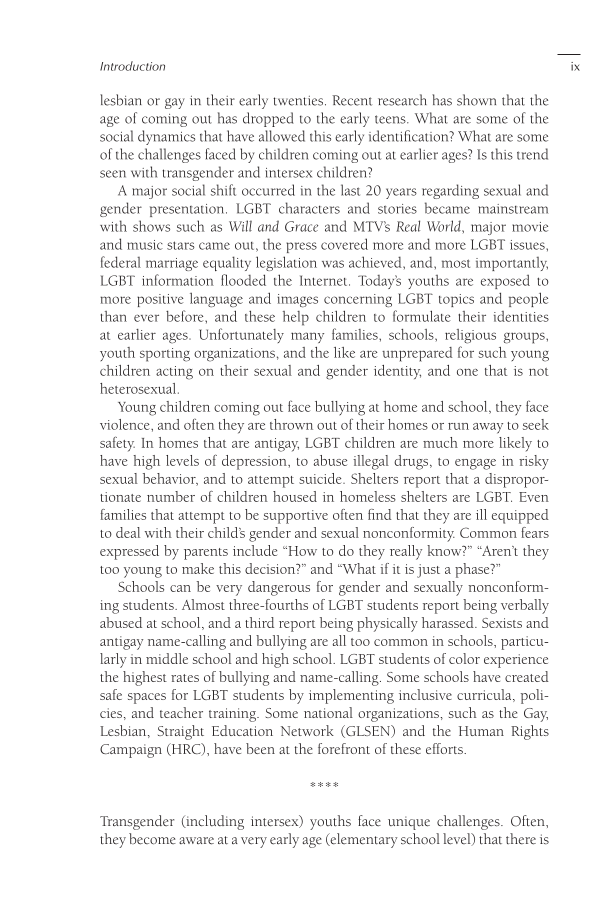Introduction ix lesbian or gay in their early twenties. Recent research has shown that the age of coming out has dropped to the early teens. What are some of the social dynamics that have allowed this early identification? What are some of the challenges faced by children coming out at earlier ages? Is this trend seen with transgender and intersex children? A major social shift occurred in the last 20 years regarding sexual and gender presentation. LGBT characters and stories became mainstream with shows such as Will and Grace and MTV’s Real World, major movie and music stars came out, the press covered more and more LGBT issues, federal marriage equality legislation was achieved, and, most importantly, LGBT information flooded the Internet. Today’s youths are exposed to more positive language and images concerning LGBT topics and people than ever before, and these help children to formulate their identities at earlier ages. Unfortunately many families, schools, religious groups, youth sporting organizations, and the like are unprepared for such young children acting on their sexual and gender identity, and one that is not heterosexual. Young children coming out face bullying at home and school, they face violence, and often they are thrown out of their homes or run away to seek safety. In homes that are antigay, LGBT children are much more likely to have high levels of depression, to abuse illegal drugs, to engage in risky sexual behavior, and to attempt suicide. Shelters report that a dispropor- tionate number of children housed in homeless shelters are LGBT. Even families that attempt to be supportive often find that they are ill equipped to deal with their child’s gender and sexual nonconformity. Common fears expressed by parents include “How to do they really know?” “Aren’t they too young to make this decision?” and “What if it is just a phase?” Schools can be very dangerous for gender and sexually nonconform- ing students. Almost three-fourths of LGBT students report being verbally abused at school, and a third report being physically harassed. Sexists and antigay name-calling and bullying are all too common in schools, particu- larly in middle school and high school. LGBT students of color experience the highest rates of bullying and name-calling. Some schools have created safe spaces for LGBT students by implementing inclusive curricula, poli- cies, and teacher training. Some national organizations, such as the Gay, Lesbian, Straight Education Network (GLSEN) and the Human Rights Campaign (HRC), have been at the forefront of these efforts. **** Transgender (including intersex) youths face unique challenges. Often, they become aware at a very early age (elementary school level) that there is
Document Details My Account Print multiple pages
Print
You have printed 0 times in the last 24 hours.
Your print count will reset on at .
You may print 0 more time(s) before then.
You may print a maximum of 0 pages at a time.




































































































































































































































































































































































































































































































































































































































































































































































































































































































































































